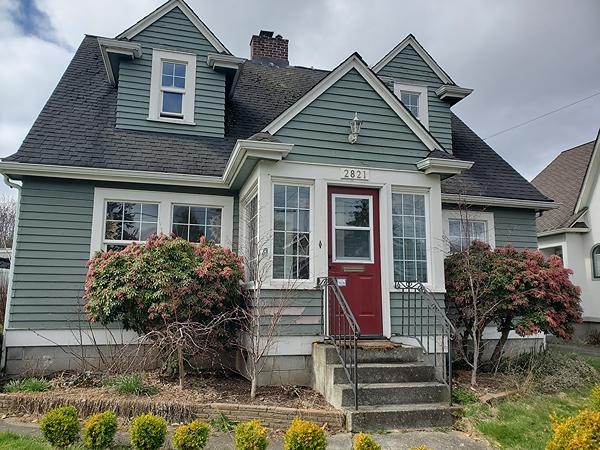
Ground Up Inspection Service
(360) 927-1723
Inspector: Adam Morvee

Summary
Unofficial version!
| Client(s): | Mr. SAMPLE |
| Property address: | 1234 Skagit St Bellingham Wa 98225 |
| Inspection date: | Tuesday, March 26, 2024 |
This report published on Thursday, April 25, 2024 9:26:33 AM PDT
This report is the exclusive property of Ground Up Inspection Service L.L.C and the client(s) listed in the report title. Use of this report by any unauthorized persons is prohibited.
| Safety | Poses a safety hazard |
| Repair/Replace | Recommend repairing or replacing |
| Repair/Maintain | Recommend repair and/or maintenance |
| Maintain | Recommend ongoing maintenance |
| Evaluate | Recommend evaluation by a specialist |
| Monitor | Recommend monitoring in the future |
| Comment | For your information |
3) Safety, Repair/Maintain - Perimeter bench seating was installed at the rear deck where walking surfaces were more than 30 inches above the surrounding grade. Bench seating is not a safe substitute for standard guardrails, and is a potential fall hazard. Gaps in such seating often allow small children to climb underneath and fall. People sitting or standing on benches may also fall. The clients should at least be aware of this hazard, especially if small children are present. Recommend having a qualified contractor repair as necessary to eliminate fall hazards around bench seating.
6) Repair/Replace, Evaluate - Rot was found in siding at the South and North. Recommend that a qualified contractor further evaluate siding and trim and replace as necessary.
7) Repair/Replace - Rot was found in the south dining window sill trim. Recommend that a qualified contractor replace rotten wood as necessary.
8) Repair/Replace - Rot was found in the front door trim. Recommend that a qualified contractor replace trim as necessary.
12) Safety, Repair/Replace - Electrical wiring for the under-sink food disposal was substandard. Non-metallic sheathed wiring was exposed and subject to damage. The wiring can be damaged by repeated bending or contact with sharp objects. BX-armored conduit should be installed to protect wiring, or a flexible appliance cable should be installed. This is a potential shock hazard. Recommend that a qualified contractor repair per standard building practices.
14) Repair/Replace, Evaluate - Significant elevated moisture levels and soft subfloor was observed in front of the bathtub at the main floor bathroom. Active leaks may exist. Recommend that a qualified contractor further evaluate and replace subfloor and flooring as necessary.
15) Repair/Replace - The exhaust fan at the main floor bathroom was noisy and vibrated excessively. Moisture may accumulate and result in mold, bacteria or fungal growth. Recommend that a qualified person repair or replace the fan as necessary.
19) Safety, Repair/Replace - Smoke alarms were missing from the main level and bedrooms. Additional smoke alarms should be installed as necessary.
24) Repair/Maintain, Evaluate - No thermal expansion tank was installed at the water heater, and the plumbing system may be "closed" based on the inspector's observation of a pressure-reducing valve installed in this system. An expansion tank should be installed to allow room for water in the system to expand. Without one, the water heater's temperature-pressure relief valve can leak or become damaged, or toilets can "run" due to excess pressure overcoming the fill valve. Recommend that a qualified plumber evaluate further and install an expansion tank per standard building practices if necessary.
26) Repair/Maintain, Evaluate - The last service date of the gas-fired forced air furnace appeared to be more than 1 year ago, or the inspector was unable to determine the last service date and it appears due. Recommend that a qualified HVAC contractor inspect, clean, and service this system, and make repairs if necessary. For safety reasons, and because this system is fueled by gas, this servicing should be performed annually in the future. Any needed repairs noted in this report should be brought to the attention of the HVAC contractor when it's serviced.
27) Safety, Repair/Replace - The facing on fiberglass batt insulation in the attic was exposed. In most cases, the facing is flammable and poses a fire hazard. Also, the facing typically acts as a vapor barrier, and if located away from the interior surfaces can trap moisture from condensation in the cavity between the facing and the interior spaces. Recommend that a qualified person repair as necessary. For example, by reinstalling or replacing insulation per standard building practices and per the manufacturer's instructions.
28) Repair/Replace - No ceiling insulation was installed in sections of the attic floor and walls. Recommend that a qualified contractor install insulation for better energy efficiency and per standard building practices.
33) Evaluate, Monitor - The older concrete sewer line was functional at the time of inspection. Based on a newer clean out installed and minor root intrusion at junctions, routine cleaning may have been performed in the past. Recommend consulting with the property owner about past repairs and services and budget for repairs/replacement in the future.
